Tagged: Gem Spotlight
Below you will find content on the site that is "tagged" with the topic: Gem Spotlight.
Fine Jewelry University (Show All FJU Articles)
-
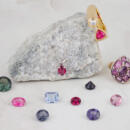
Gem in the Spotlight: Spinel
Spinel may be one of the most underappreciated gemstones in all of history. For centuries it has been confused with more popular gems like ruby and sapphire, and only recently have people begun to appreciate spinel for its own natural beauty. Commonly made in a lab spinel has been used a lower cost substitute for other gems, but natural spinel is actually a stunning gem in its own right. This in-depth article covers the gemology, history, and lore of this amazing and often overlooked gem... read more »
-

Gem in the Spotlight: Alexandrite
Emerald by day, ruby by night, more expensive than diamond and more illustrious than sapphire, emerald, or even ruby, alexandrite has been known around the world as one of the most sought-after gems for the better part of 200 years. But, what makes this stone so special? Gemology of Alexandrite Alexandrite is the extremely rare, color-change variety of a gem species called Chrysoberyl. It appears bluish-green in daylight, fluorescent light, and some LED light. Under incandescent light, candle, and firelight, alexandrite appears purplish-red. This is because of how the trace... read more »
-
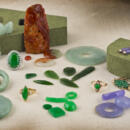
Gem in the Spotlight: Jade
Jade has one of the richest heritages of all gemstones. People have been using jade from as early as 6,000 BC, and it has been an incredibly important part of Asian, Central American, and North American history ever since. But, what is jade, and what has given it such a prominent place in human history? The term “jade” actually refers to two completely different gems: nephrite and jadeite. These are actually two unique mineral species, but since they have been confused for so many years, and are similar in many... read more »
-
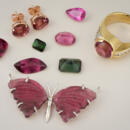
Gem in the Spotlight: Tourmaline
Tourmaline is a beautiful gem that comes in a huge variety of colors (sometimes even within the same stone). This article teaches you all about the history, folklore, and gemology of tourmaline including varieties like rubellite, indicolite, paraíba, and more. You'll also learn about California tourmaline and the unique piezoelectric property that has made tourmaline as useful as it is beautiful... read more »
-
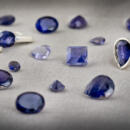
Gem in the Spotlight: Iolite
Iolite is maybe not the first gemstone people think of for their blue-violet jewelry, but it should be near the top of the list. Iolite’s color range of blue, blue-violet, and violet competes for public attention with sapphire, tanzanite, and amethyst. They may have name recognition, but iolite has a rich, unique color and great gem value on its side. It is more subtlety nuanced than amethyst and deeper than many tanzanites. Iolite’s name comes from its violet color. It is from the Greek word “ios” meaning violet. Unlike many... read more »
-
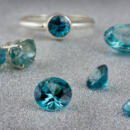
Gem in the Spotlight: Blue Zircon
Zircon may be last in the alphabet of gemstones, but it is first in sparkle. The crystal structure of zircon creates one of the liveliest displays found in any colored gem. In fact, before any of the manmade diamond simulates were made, the colorless version of zircon was used in jewelry to mimic diamond. Why? Natural zircon is known for its scintillation, brilliance, and flashes of color or fire just like diamond. Zircon also is known for its variety of colors. Blue zircon is the most popular color. But, zircon... read more »